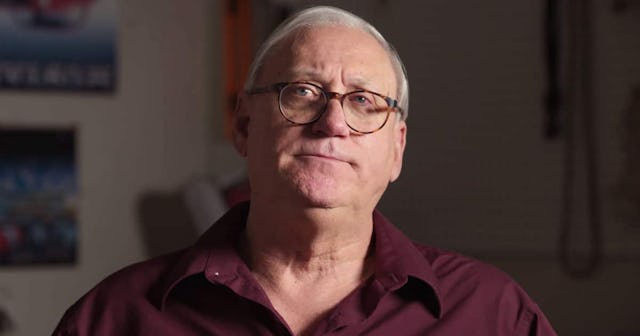Why Netflix's 'The Pharmacist' Was So Triggering For Me

I lost track of my father for about a year. One afternoon my brother came to me, abruptly, and said he’d found our dad. I don’t know how, but we drove to where he said Dad lived, a small home in a suburb of Springville, Utah. I suppose it was serendipitous that we happened to find him that day, as he was hunched over in his grey Ford pick-up truck, one foot wedged on the brake, the truck in neutral and sitting in his driveway.
He’d overdosed on painkillers, although we didn’t know that at the time. We called for an ambulance because he was unresponsive. As we waited for it to arrive, Dad started making this horrible sound, gasping for air and foaming at the mouth. I couldn’t help but think of that moment as I watched Netflix’s “The Pharmacist,” because now I have a name for that sound. It’s called the “Death Rattle.” It’s the sound addicts make when they overdose and struggle to breathe. I was 13 years old when I heard that sound. My brother was 16. We saved our father’s life. But he didn’t stop using, and he ultimately died from his addictions five years later.
I’ll be honest, as someone who lost a loved one to the opioid epidemic, watching “The Pharmacist” was difficult. It follows the actions of Dan Schneider in the late ’90s and early 2000s as he catches his son’s killer after a bad drug deal. His son’s death propels him to start looking at the Oxycontin prescriptions coming from his own pharmacy differently, and wonder if he was becoming a killer himself.
My father died in December of 2001, so for someone who lived it, I couldn’t help but feel old memories stirred up as I watched this four episode true crime docuseries discuss things I was too young to understand, but found so very recognizable. As far as I know, my father never went to a pain clinic like the one run by Dr. Cleggett in Dan Schneider’s small town outside New Orleans. But I can remember going from one doctor to another with my father, him complaining of pain, and leaving with multiple prescriptions. And then going to multiple pharmacies to get them filled. My brother and I used to jokingly call his doctors his drug dealers, and apparently this wasn’t unusual behavior for pill addicts in the late-’90s.
I remember wondering how he was able to do this, only to discover by watching “The Pharmacist” that my father was caught up in a in a dangerous sales pitch pushed by pharmaceutical manufacturers that convinced doctors to complacently put patients on more and more pain medication.
Netflix/Youtube
From what I understand, my father had a couple surgeries in the early ’90s, one for an ulcer and another for a hernia. They were within a year of each other. He was prescribed one bottle after another until he became nothing more than an opioid addict, in and out of jail, spending every dime he had in the pursuit of more painkillers.
I can still remember cleaning his apartment after his first conviction for forging pain pill prescriptions and driving under the influence. I wandered his small, run-down apartment putting pill bottles in a large black garbage bag: Oxycontin, Soma, and Xanax. According to “The Pharmacist,” this combination has a name, too — the Holy Trinity, because when combined, it is the closest someone can get to the effects of heroin. This is what Dr. Cleggett was prescribing which caused Dan Schneider to put his hand up and say, “Something is wrong here.”
Courtesy of Netflix
By the time I was done cleaning my dad’s apartment, I’d more than half filled the garbage bag. Each prescription was made out to my father, and I remembering thinking, “How can this be? How is it legal for one person to acquire this many prescription pills?”
But I must say, two things hit me the hardest watching “The Pharmacist.” One was that I still harbor a lot of resentment towards my father, because frankly, he did some horrible things to me and to my family. Right now I’m 37 with three children. Sometimes I think about what I have with my kids, and how I could’ve had that with my own father were it not for his drug addiction. I can’t help but feel bitter about that because I now understand the value of a father-child relationship. He hurt a lot of people. And yet, people spoke highly of him before his addiction. I hardly knew that man, and I am left wondering how much he is to blame for his actions, and how much is to blame for an addiction he fell into.
Courtesy of Netflix
Second, I couldn’t help but think about all the doctors and pharmacists I visited with my father during the ten years between when his addictions started and his death, and wonder why no one ever did exactly what Dan Schneider did in his pharmacy. Why didn’t anyone ask him why one man was being prescribed so much? If there had been a Dan Schneider in rural Utah, would my father still be alive today? Would he be here so my kids could climb on him and call him Grandpa? Would my dad be alive, healthy, and drug free?
Netflix/Youtube
I suppose most of us who lost a loved one from the opioid epidemic are left asking those same questions. But I must say, shining a light on it, showing the parts, and the errors, and the greed, is what we need right now to prevent another epidemic. And that right there is exactly what “The Pharmacist” does, and it is exactly why it is such an important story right here and now, in 2020.
This article was originally published on